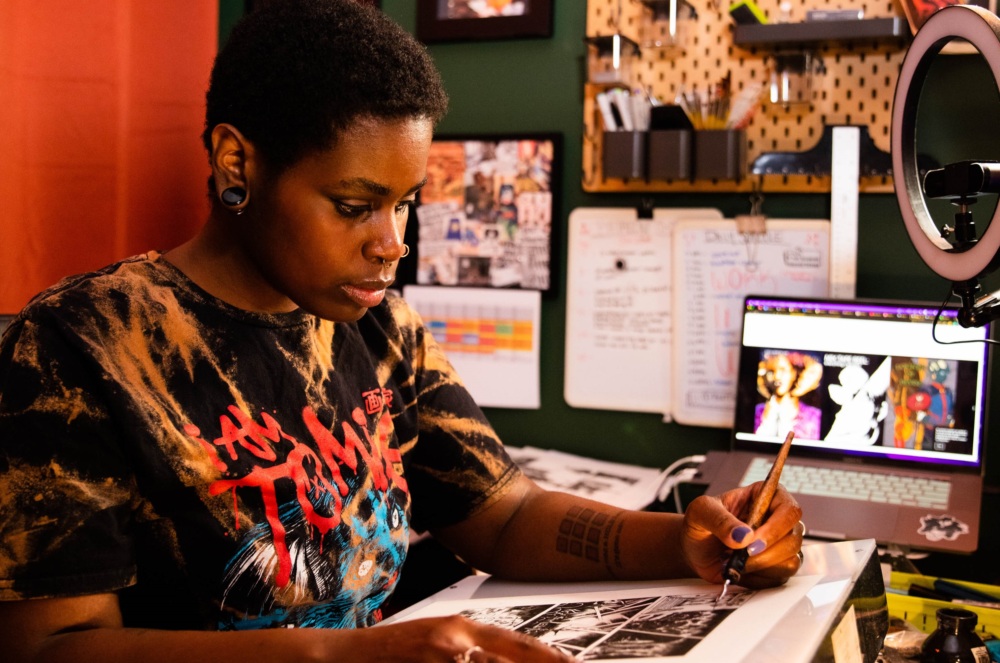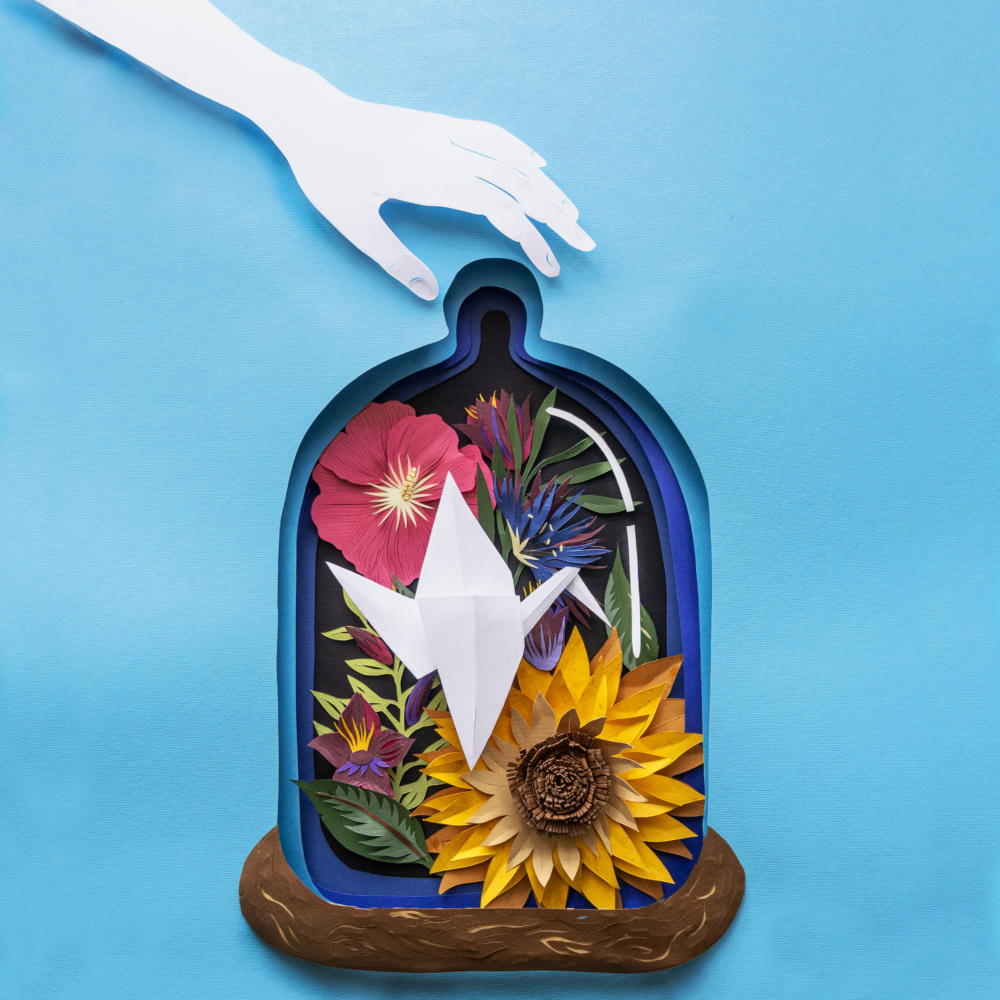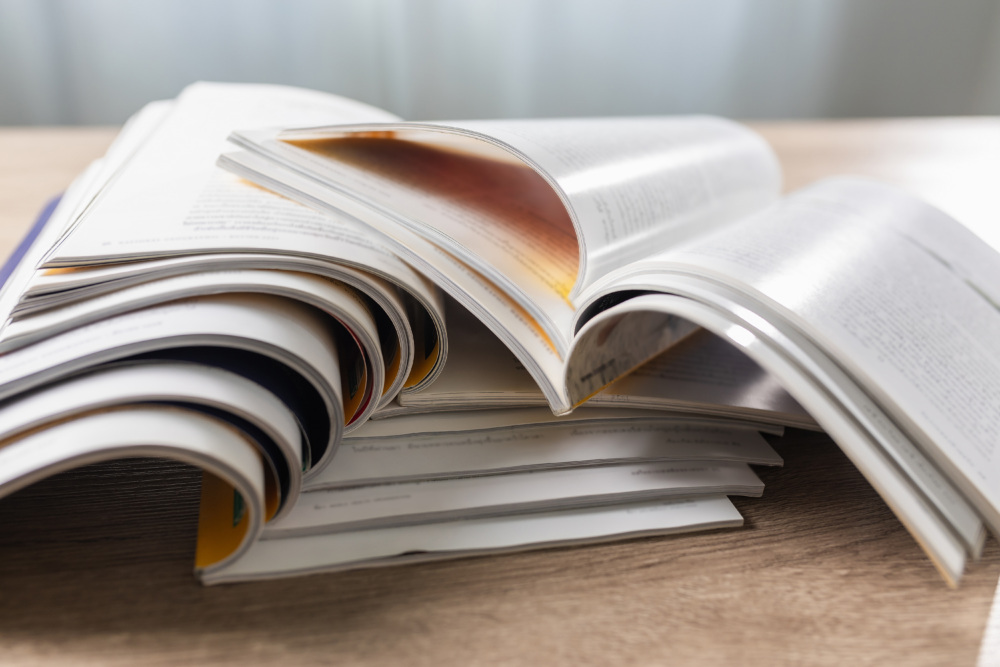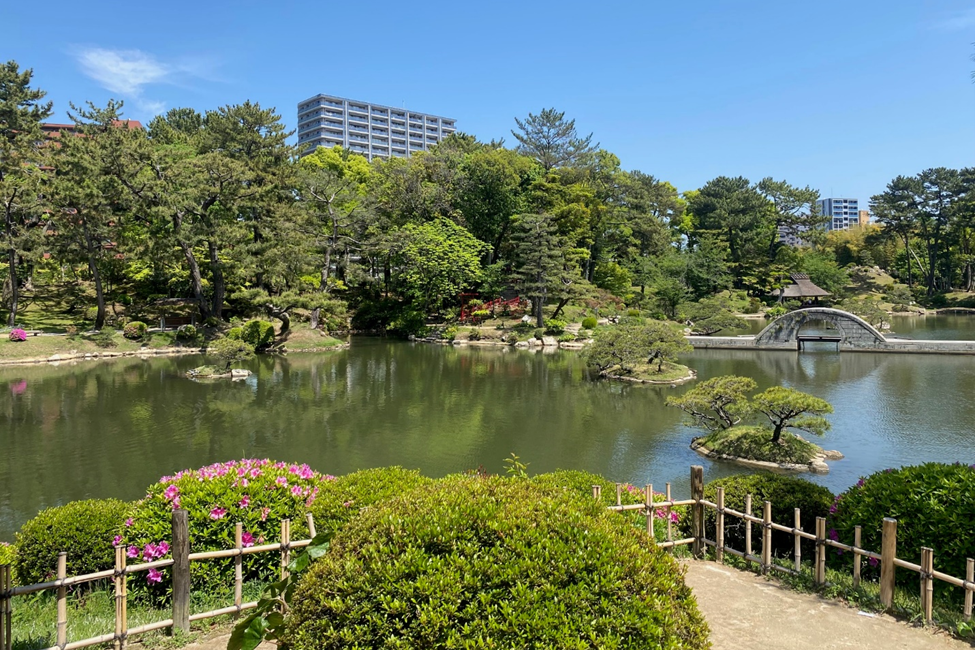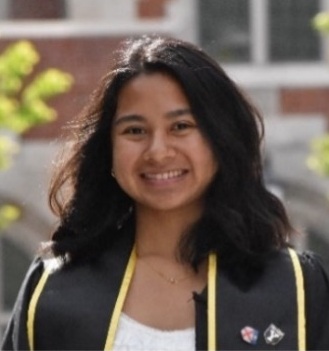
Hannah Hernandez
Intern, Communications
Atomic Pulse
Gigi Murakami is an American freelance illustrator and manga (comic) creator based in Brooklyn, New York. Her work blends Japanese manga art and vintage American comic and pulp aesthetics. She contributed to #CranesForOurFuture by designing an engaging and provocative mural centered around the history and future of nuclear weapons. The mural is wheatpasted in locations across Washington DC and New York City.
The mural you created for the #CranesForOurFuture campaign is gorgeous—and so powerful! What inspired you to work with NTI and create a piece of art to address nuclear threats?
So, I actually have Japanese family. I, myself, am not Japanese in nationality or heritage, but my husband is Japanese. And I’m a big fan of Japanese media, like anime and manga. So, growing up, I did see a lot of depictions in manga and anime with images like the mushroom cloud. I didn’t understand its relevance until I got older, and I learned about World War II, how the bombings specifically affected the psyche of the Japanese, and how that manifested into their media. Because I am now married to a Japanese man and I have Japanese family, it was important to me to take on this project to make them proud, but also to advocate for the wider world. [Nuclear weapons] are not anything to play around with. It is something that is much bigger than us and something we can’t control. They aren’t necessary, and I feel very strongly about that. For these reasons, I was so honored when NTI reached out to me to work on this campaign.
Your work blends Japanese manga art with vintage American comic and pulp aesthetics. What drew you to these types of art and inspired you to blend them together?
I had my light bulb moment in 2020 when the world was still, and we didn’t have much to do other than sit and think. During that time, I was reflecting on my artwork, and I felt like it wasn’t saying anything at the time. It just didn’t have any impact. So, I decided to combine the things that I really loved since I was a kid.
Some people have a favorite war era or a favorite war that they like to study or research. For me, that was World War II. During that time, there was a lot of artwork done with the propaganda posters as well as movie poster designs in American cinema. The artwork of these posters stuck with me. I also love horror for its pulp comic covers, which was very prevalent during World War II as well. And as I mentioned, I also watched anime and read manga as a kid. That’s how I sort of came up with my style.
Can you share the process behind your creative thinking and strategizing for the #CranesForOurFuture mural?
At first I was kind of like, I’ve never really done anything like this before with such an impactful message. How can I do this? And then I learned about the story of Sadako Sasaki. The [atomic] bomb hit was when she was two years old. In the second grade, she developed leukemia as a result of the bomb and unfortunately passed away. That was the first time that I had heard about her. I did know about the cranes story – the Japanese folktale that if you fold a thousand paper cranes, your wish will be granted – but I didn’t know that that story was connected to her. So, I reacted very strongly to her story. I’m trying to not get emotional, but it’s very unfortunate that an innocent child had to pass like that because of people who weren’t able to figure things out in a way that didn’t end up in mass murder. I was very struck by her story, and I wanted to lead the story creatively with her in mind and use her story as an example as to why we don’t need these weapons. [Sadako’s] life was cut short in the way that it was because of these weapons.
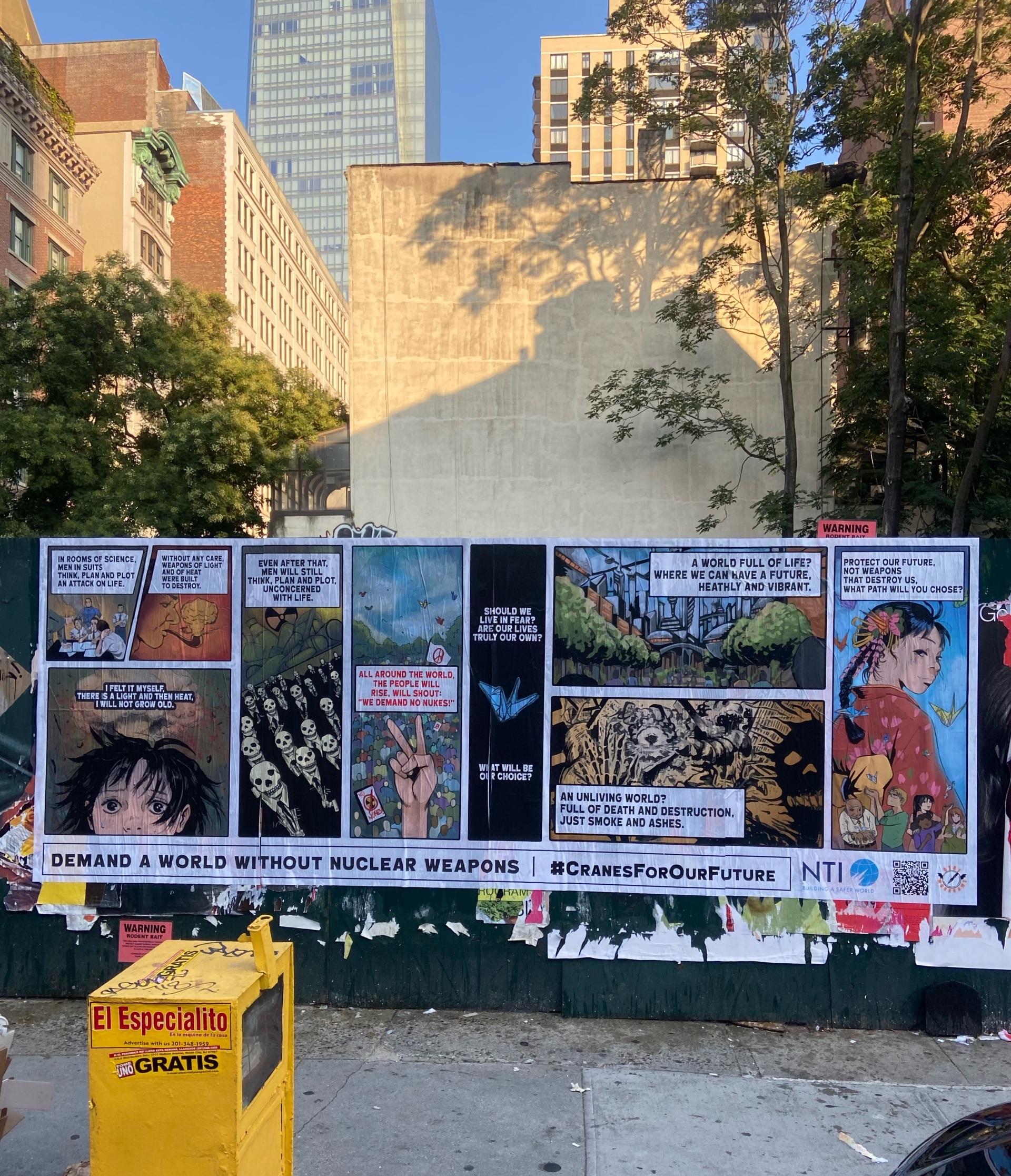
The mural includes various allusions and symbols relating to the history of nuclear weapons and a future free from nuclear weapons. Can you explain what these allusions and symbols are and what they mean?
There’s one panel where there are these politicians that are not just politicians, but these men in suits that have the power to launch these weapons. I chose to create them as skeletons because while the goal is for power, control, and this mentality of domination, I think that it’s a fool’s errand. Everybody is affected by [nuclear weapons]. It’s not just your enemy that dies. These weapons cause such destruction, even with the aftereffects. So, I chose to depict [the politicians] in suits and skeletons. And they’re all in uniform. They’re all the same. They have the same mentality of dominion over and anger towards the “enemy.” At the end of the day, we all look the same regardless of if we are an enemy or not.
Your mural also gives a nod to Oppenheimer and atomic bombings by using a haiku. Can you share more about what went into those decisions?
I was actually working on the storyboards for this project while I was on my twitch stream. My audience is so amazing because when this project came up and I was talking to them about it, the idea of a haiku came up. I was in love with that idea but was worried that the message of the mural wouldn’t come across.
I feel like the message that needed to get across got across, and there were some changes that we had to make to some of the wording. But for the most part, I would say about 80% of it is still that original writing of haikus – maybe 85%, 90%. But it turned out to be quite fun actually – to try to get the message across within those confines.
There are many ways to engage people in advocacy and raise awareness about important social issues. How does art play a role in demanding a world without nuclear weapons?
That is a good, good question. I will say that all forms of art can play an incredibly important role, I think a more important role than people actually give art credit for. Film was a very efficient tool for the Nazis, for example. And this is on the opposite side of what we want, obviously. But the point is, is that this is still a creative medium. These tools are very, very powerful.
I do think that narrative is always useful. It is always something that can very easily connect people to one another. Using creative tools that that can frame narratives is the best way to use art for advocacy and for talking about very important issues that affect all of us. Regardless of whatever artistic medium you’re using, narrative should be the name of the game. People relate very deeply to stories. People relate very deeply to characters. People relate to those that they see some themselves in. I think it’s very powerful tool for advocacy, especially with the way social media is and people’s attention spans being all over the place. Telling a very good story is probably the best way to educate others.
I agree, I think especially in the field of nuclear policy, there is a lot of jargon that prevents people from being able to understand what’s happening. But by taking concepts and issues in nuclear policy and incorporating them into art such as a comic strips or murals, we close the gap between political discourse and public understanding and can engage more people in calling for a world without nuclear weapons. So, knowing the power that art has in shaping the world, what is your hope for a safer future?
There’s a lot going on in the world right now. As I mentioned, I am married and I don’t have any children, but I would like to. But I am very nervous to bring and raise a child in this world because it is very scary with all the things going on and, of course, the overarching threat of nuclear weapons being used.
I think my hope would be for the success of this campaign and for people to read through this comic and really think critically about what’s being depicted, especially in that alternative world where nobody can grow old. Where nobody can have children. Where you are stuck forever at your age. You are just gone. There is nothing left when these things hit. Everything is gone. I don’t think that human beings can comprehend that. So, it is my hope that through this campaign and through this artwork people can see that is not a world that we want. That’s not a world that I want. I would like to have children. That’s not a world that I want for them. My hope is that people take this very seriously and people do what needs to be done to make sure that we don’t have these weapons anymore and that we never, ever use them again.
We talked about a lot of serious things today.
I’m going to have a good cry after this meeting.
I think I will, too. On a lighter note, I was wondering, because you’ve been doing art for so long, what has been your favorite thing about your job and being able to express yourself creatively?
I self-publish my own manga, and I am primarily a horror artist. I love horror. And I think my favorite thing about expressing myself is using art as a metaphor or an allegory for things that are actually happening. And it doesn’t always have to be as serious as a topic as this project.
I love when people respond to my work and they just get it. There’s nothing that has to be explained. There’s nothing that is lost in translation. People relate on a more primal level because it’s horror. I really like that about what I do, and I like that I have the freedom to do that in my art.
Thank you so much for your time. It was a pleasure speaking with you and learning more about your art, creative thinking, and how you use as a tool for advocacy.
Thank you for choosing me to do the mural! This project means so much to me and my husband.
Sign up for our newsletter to get the latest on nuclear and biological threats.
Eugenia Zoloto is a Ukrainian artist who specializes in paper cutting, collages, and illustrations, in addition to working with oil paints and mixed mediums. She lives in Kyiv with her husband and two children and is participating in the 2023 #CranesForOurFuture campaign by contributing a beautiful floral sculpture featuring an origami crane.
If you want to learn more about Oppenheimer’s bomb and what we must do to protect the world today and for future generations, NTI’s online library is the perfect place to go.
"Visiting Hiroshima imparted to me a deep sense of responsibility as well as a renewed energy to work towards a world without nuclear weapons," writes Program Officer Ananya Agustin Malhotra.
